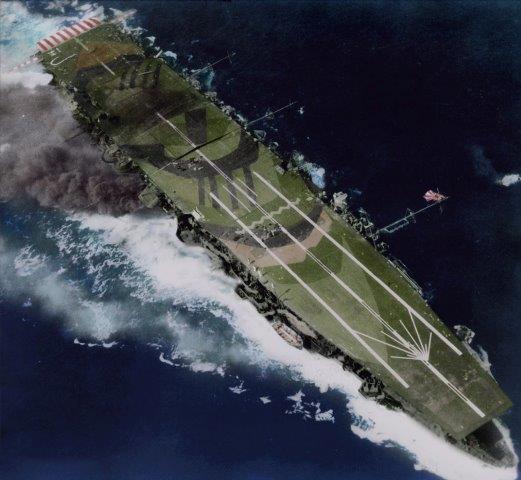HIJMS Zuiho
Scale 1:100

by Jason A, Montreal, Canada

| Historic Overview:
The Zuiho (Lucky Phoenix) was one of two sister light carriers converted from submarine tenders by the Imperial Japanese Navy. Her sister, Shoho, had the ignominious fate of being
the first aircraft carrier sunk in the Pacific war as she took part in the first battle in history where neither surface fleet saw one another. The now famous term, "Scratch on flattop"
was first uttered over the radio by an American airman as he watched the Shoho sink. The Zuiho, on the other hand, fought in the Pacific war for 3 years and saw action in several battles.
She was sacrificed, along with several other carriers, in the Battle of Cape Engano in late 1944 to give Admiral Kurita's surface force time to decimate the landing forces at Leyte.
He did not deliver on Zuiho's sacrifice.
One of the most famous images of the late Pacific war was of the Zuiho on her last day afloat as she twisted and turned, fruitlessly, to escape her doom. The clarity of this picture is astounding (see the colourized version above). Her crazy camouflage paint is clear for all to see, her flight deck is buckled slightly from damage sustained and she is pouring out black smoke as she strains at full speed to escape her attackers. One can even see the gun crews manning the 25mm mounts. My build is of the Zuiho as I imagine her to have been in the early morning of that day, back on the 25th of October, 1944. For that last sortie, the Japanese navy could only muster 12 A6M5 Zeros and 5 B6N1 Jills for the Zuiho; little more than half her potential compliment of 30 planes. It was a clear sign that the inevitable end of the Nihon Kaigun was close at hand. Build Duration: July 2016 to February 2018 The Model: The plans I had were of a card stock paper 1/200 scale model of the Zuiho. Using Photoshop I enlarged all the plans and got down to building. One blessing and curse was that there are no definitive detailed plans of this ship. Indeed, several plans actually contradicted each other in major ways. I referenced both the Hasegawa and Aoshima Zuiho 1/700 kits, internet images and a myriad of Japanese and English texts from my personal collection. A big shout-out is necessary to the folks at the j-aircraft.com forums for their assistance and expertise. I asked a myriad of questions over the course of the 6 months I planned out the build and all through the actual construction. I asked some tough questions and, at times, even their knowledge had gaps. There was no clear way to discern certain things: the placement of the four twin 25mm mounts? The placement of the single 25mm guns? I had to make some hard choices based on blurry photos, understanding Japanese Naval doctrine at the time and good old common sense. The references for the weapons, life rafts, ground tackle etc were all taken from the Anatomy of the Ship (AOTS) Takao and Yamato books; these two tomes provided a wealth of knowledge and detailed drawings of the more generic Japanese equipment. The Zuiho was converted in the same decade that both the Takao and Yamato were built so I assumed most of the equipment would have been similar, if not the same. A few Gakken books of other Japanese carriers, from my collection, were also used as references. What made the Zuiho an especially interesting build was the myriad of changes or evolutions that the Zuiho underwent from her commissioning in late 1940 to her sinking in late 1944. The flight deck was extended 12 meters (41') forward covering more of the bow, four twin 25mm guns were added in the bow, four triple 25mm guns were added to bow bandstands and amidships, all the aft starboard gun mounts were replaced with guns with smoke shields, 6 rocket mounts were added, many single 25mm guns were added including those on sleighs attached to the flight deck. Indeed, if you place the Shoho of 1941 next to the Zuiho of 1944 they look markedly different to the discerning eye. The 1944 Zuiho was a more dangerous adversary. Two frequent questions I got from people who saw the ship build progressing were: 1. Why such a large scale? My answer was "Why not?" I have always wanted to build a warship in this scale and toyed with the idea of the Takao or the Fuso, but those models were much more complicated. A light carrier was "simpler" and would be a good "beginners" project into building in this scale. Besides, no one is selling large warship kits in this scale and, if they are, they are charging thousands of dollars for such a kit. Certainly the Zuiho would never be mass produced in this scale, so the finished product would be quite unique! 2. How do you stay focused on such a monumental project? No one I know builds models, so this question is expected. What I found got me through this build was the "think small" mindset. I needed to tackle each task and try not to think about the larger project as a whole. Indeed, when I look back on the early pictures, I can understand why everyone who saw it thought I was nuts! It reminds me of the old adage where a man approached three bricklayers working away. He asks each one, in turn, what he is doing. The first bricklayer says, "I am laying this brick." The second bricklayer says, "I am building this wall" and the third bricklayer says, "I am building a cathedral". I was definitely the first bricklayer! It was the only way to keep whatever remained of my sanity intact! On to the journal of the build! |
|
|
Click here to go on to part 2. |
